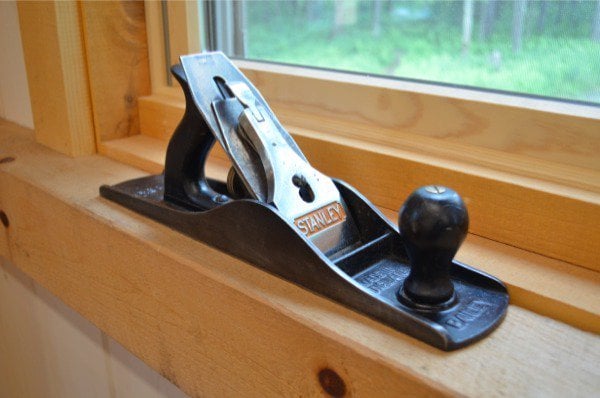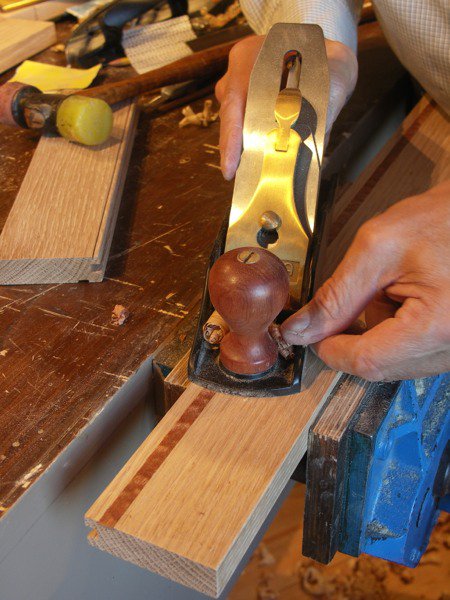Questions Answered -Considering Longer Planes
For more information on planes, see our beginner site Common Woodworking.
Question:
Hi again Paul,
Just wondering what your thoughts are on no 7 Jointer planes? I’m considering getting one, and cannot quite afford the price of the Veritas model. However I have seen a few of the Quangsheng jointers which look very good.
Do you have any other recommendations?
Thanks,
Tom

First off I think that it is true that all plane soles move with exchanges of temperature and, so, because atmospheric conditions constantly change from day to day and hour to hour, the soles of planes do shift in greater or lesser measure from time to time. Because I have rarely found longer planes to stay dead flat (and dead flat is relative) I tend to prefer shorter planes such as the #5 and 5 1/2 or a #6. I can do everything I need with these extended length planes. That said, I have longer planes all the way up to the #8‘s. Mostly because I found them for a bargain. 

Keeping things in balance is always important.The longer planes do have a place at the bench and I would not be without the #6, 7 and 8 planes I own, but I never really use the #7 and 8 planes for flattening or straightening because they are rarely truly straight. I also have to say that even though better quality planes are more rigid in the sole, I haven’t found them to be consistently true because of changes in the steel caused by different elements that markedly affect them. These differences can be sole-hollow, sole-round and sole-twisted. Any one of these elements will result in a twist, hollow or round in the wood. That said, they are often straight enough and can still usually be flexed mid-stroke if necessary. On the other hand I have found that wooden-bodied beech planes give the most consistent resistance to change and to flex in use.
I still use my very faithful Stanley and Record planes without retrofitting them with thicker irons and they work exceptionally well. There is nothing wrong with retrofitting if you like the idea of thicker, harder steels and the added work it takes to sharpen them. I certainly have never found much beneficial difference and so wouldn’t do that or advise anyone else to do it either. This is my personal view. We can always improve what’s available and indeed some engineers have improved some aspects of the tools woodworkers use.
In answer to Tom’s question. Buy a #5 and a 5 1/2 first. Use them for a few months and see how they feel and whether they d what you want. The look for a the bargain #6, 7 and 8. I think you will do the same as me. Long metal planes are very unwieldy and flex very easily. They can also be difficult to balance on the edges of narrower wood. You must learn to be sensitive in using them. That will be fun!


I concur with what Paul said, I do own a #7 in both a Stanley Bailey and a Keen Kutter K series ( this plane is similar to the Bedrock round side ). Before I had these I used my #6 and still use my #6 more than my #7, I do not own a #8 but own a 28″ wooden Jointer plane which is very nice.
I find I am using my #4 Bedrock more than any other plane I own and all of my planes are vintage I do not own any newer bench planes.
Paul I have a question for you and that is about the Woden that I have seen you use, I have never heard of them before but they do look like a nice plane.
Steve
They were made up until the 60’s. Some say they were made by record but i don’t know that that’s the case. The man who trained me owned a Woden 4 1/2 and I always wanted one but before eBay they were hard to get hold of. Some things have really helped to distribute tools amongst the non-collectors and i think that’s great. Many tools have gone off the working shelf and onto the collectors and so tools that should or could still be in use were disappearing.
The Keen Kutter K series effective is an old Bedrock – Stanley sold the maker of Keen Kutter (I cannot remember their name…) the patterns for the first Bedrocks after they changed to the square-tops.
So the #6, #7 and #8 “have their place at the bench,” but you “don’t use them for straightening and flattening the work?” What do you use them for then? On another blog on this topic you said “very fine work” but didn’t get into more detail. I wonder if the internet’s habit of taking you too literally has made you cautious about saying what you really think?
I am not so sure about the 7 and 8. I certainly don’t need them nor feel they are useful for straightening and flattening longer stock. A #6 will do the job best.
I plan on doing a more in depth blog and video on the whole range of bench planes in the new year so i will answer this more fully then.
Hi Paul. To go from very long planes to very short ones: I don’t think I’ve ever heard you mention a block plane. A cabinetmaker I know uses one as his first recourse, not just for trimming endgrain but for smoothing and shaping and a host of other things, in rather the same way as I think you favour your smoothing planes. Do you ever find yourself reaching for a block plane?
I am going to reply to this on my blog if that’s OK.
Interesting observation Mark. I just read (in 3 different places!) that the late Alan Peters (an acclaimed British furniture maker) supposedly used a #7 plane for just about everything! Another English woodworker on youtube plumbed for the 5-1/2 being the one to get if only getting one plane. Perhaps this is a case of the actual tool being much less important than how you use it. Or perhaps it is a case obtaining great results despite the choice of tool rather than because of it. You get comfortable with the tools you use most.
Paul often recommends the #4 (but oddly not in this article), which is by far the most common size in the UK. It was and probably still is the plane most (hobby) woodworkers buy first and often it is the only plane they buy. They are readily available new & secondhand => cheap 🙂 but also effective.
Similarly traditional Swedish wood carvers can do amazing things with just a single knife (often an inexpensive Mora/Frost 106) and perhaps a hand axe.
More on Alan Peters: https://en.wikipedia.org/wiki/Alan_Peters
https://www.youtube.com/watch?v=x4N0KHV0n1g
I know Paul may not agree with this but I’ve always told people getting started in hand work with wood that their first plane should be a good #5 1/2, preferably vintage.
Properly sharpened and tuned,they will smooth as well as a #4 and are much easier to manage when edge jointing and hogging off heavier cuts when thicknessing rough stock.
Their length and heft make them the perfect choice for use with a shooting board which newer woodworkers will use often while refining their saw skills.
A few years ago, a friend gave me his fathers planes in a customer fitted box. He had built and installed custom trim and bookcases for over 50 yrs. using these tools. there was nothing longer that a #6 in the case. That pretty much settled the need for longer planes with me.
I recently built a Roubo style bench from scraps of pine framing timber. After dressing all round and scarfing lengths as short as 500mm to make 83mm x 34mm lengths I glued up to make a solid deck 2.4m x 0.8m x 80 mm thick.
I planed with the electric hand plane first to get rid of glue and flatten reasonably and then started planing with a Stanley no 5 I inherited and is over 70 years old. It worked fine. Then I got a Lie Nielsen low angle jack and finished with that. It was noticeable more solid and better able to cut through the knots and grain reversals. I had a $20 Chinese wooden body plane I tried as well. It cuts ok but the heft and rigidity of the Low angle jack along with the length of time between sharpening made it my preferred option. Maybe if I flattened the Stanley, set the mouth and honed the blade carefully I could have made it better and narrowed the difference but the jack was easy to sharpen, set and use.